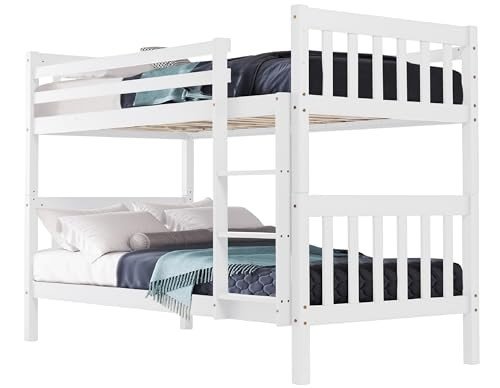Bunk Beds Sale: A Comprehensive Guide to Choosing the Right Bunk Bed for Your Home
Bunk beds have long been a staple in children's bedrooms, offering a mix of space-saving efficiency and fun. Whether accommodating brother or sisters, pals on pajama parties, or simply optimizing a playroom, bunk beds have become a vital component in modern-day family homes. As sales on bunk beds increase, it ends up being progressively essential for consumers to make informed decisions when acquiring one. This post will cover the basics of buying a bunk bed, from types to safety functions, as well as pointers for keeping the integrity of your investment.
Kinds Of Bunk Beds
When considering a bunk bed sale, it's crucial to understand the different styles available on the marketplace. Below are the most common types:
- Traditional Bunk Beds: These consist of two beds stacked one above the other, sharing a single frame. They are often the most affordable option.
- L-Shaped Bunk Beds: This style includes one bed positioned vertically and another horizontally. This arrangement develops additional space beneath the upper bed, which can be utilized for storage or a backyard.
- Lofted Beds: Similar to standard bunk beds but without any lower bed. Instead, the space below can be utilized for a desk, play location, or extra storage.
- Triple Bunk Beds: For households with a bigger number of kids or regular slumber parties, triple bunk beds provide 3 sleeping areas in a space-efficient style.
- Futon Bunk Beds: These styles combine bunk beds and futon couches. The bottom area transforms into a different seating area, boosting functionality.
- Convertible Bunk Beds: These beds can be separated into two private beds, making them versatile as children's requirements change over time.
Table 1: Comparison of Bunk Bed Types
| Type | Description | Space Efficiency | Extra Features |
|---|---|---|---|
| Conventional Bunk Bed | 2 beds stacked vertically | High | Easiest style |
| L-Shaped Bunk Bed | One vertical and one horizontal bed | Moderate | Play or storage space |
| Lofted Bed | Raised bed with open space below | High | Work/play area |
| Triple Bunk Bed | 3 stacked beds | Extremely High | Accommodates more users |
| Futon Bunk Bed | Bunk bed with a convertible futon | High | Multi-functional |
| Convertible Bunk Bed | Can be divided into 2 separate beds | Moderate | Versatility & & longevity |
Security Features to Consider
Safety is critical when buying a bunk bed. Below are key safety features to look for:
- Guardrails: Adequate guardrails must be present on both sides of the upper bunk to avoid falls. They should be at least 5 inches higher than the bed mattress.
- Ladder Design: Look for tough, large ladders with slip-resistant rungs. Ensure that the angle is not too steep for easy access.
- Stability: Ensure the bed is constructed with strong products, such as strong wood or sturdy metal. Bunk Bed Sales deedrasanchz.top ought to not wobble when in usage.
- Weight Limit: Check the weight capability of the bunk bed to guarantee it can accommodate the designated users securely.
- Product Safety: If possible, select beds made from non-toxic products or those satisfying security standards for children's furniture.
Table 2: Essential Safety Features
| Function | Description | Value |
|---|---|---|
| Guardrails | Sides of upper bed to prevent falls | Important for kid safety |
| Ladder Design | Strong, slip-resistant rungs | Help safe and simple gain access to |
| Stability | Construct quality to avoid wobbling | Makes sure security and durability |
| Weight Limit | Optimum weight capability | Prevents mishaps |
| Product Safety | Non-toxic, safe products | Safeguards children's health |
Maintenance Tips for Bunk Beds
To extend the life of your bunk bed and ensure continuous safety, think about the following upkeep tips:
- Regular Inspections: Periodically inspect the structure for loose screws, bolts, or any indications of wear. Tighten fasteners as necessary.
- Tidy Periodically: Dust and clean the surface areas regularly. Use appropriate cleaners that will not harm the finish.
- Check Weight Limits: Be mindful of weight limitations, particularly with older kids or adults who may wish to use the upper bunk.
- Prevent Climbing on Guardrails: Educate children not to utilize guardrails for climbing or playing to reduce the danger of accidents.
Often Asked Questions (FAQs)
Q1: What is the age limit for kids to safely use bunk beds?A: While it varies by the producer, lots of suggest that children under six ought to not sleep in the upper bunk due to safety concerns.
Q2: How can moms and dads dissuade risky climbing?A: Setting clear rules about bunk bed usage and monitoring children can assist. In addition, using a bed tent can discourage climbing up while creating an enjoyable sleep environment.
Q3: What should I consider when embellishing a space with bunk beds?A: Ensure there is adequate space around the bunk bed for safe movement, and utilize the decor to produce personalized areas for each child.
Q4: Is a lofted bed appropriate for older children?A: Yes, lofted beds can be suitable for older kids as long as they satisfy safety requirements and the kid is responsible enough to utilize them safely.
Bunk beds serve a functional purpose while including a component of enjoyable to a child's bedroom. As sales of bunk beds continue to rise, careful factor to consider of types, safety features, and upkeep practices is necessary for parents and caretakers. By understanding these essential elements, families can find the best bunk bed for their home, ensuring both practicality and security for years to come. Whether it's for siblings sharing a space or creating a relaxing sleepover space, a well-chosen bunk bed can supply happiness and functionality, making it a deserving investment.

